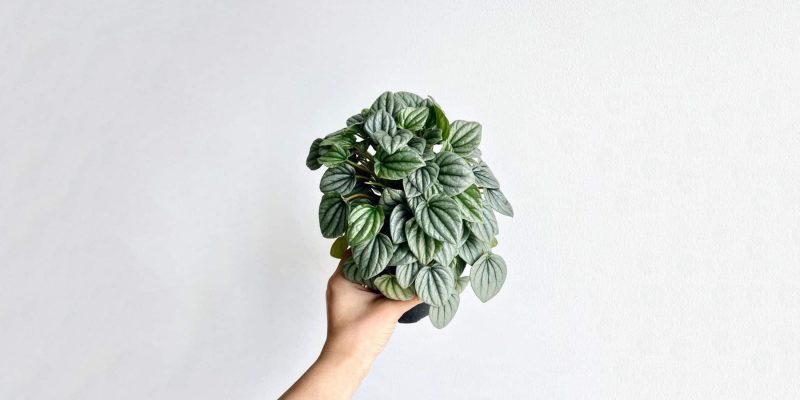All it takes is one glance at the Peperomia Frost’s silvery-green leaves to truly appreciate its elegance and beauty.
If you’ve just recently discovered peperomias, then you’re in for a treat. With epiphytic, lithophytic, and xerophytic varieties, the Peperomia genus is a treasure trove of charm.
In this article, we’ll guide you through everything you need to know about Peperomia Frost care, from essential tips to propagation methods.
Table of Contents
Peperomia Frost Plant Care Guide
History, Habitat, and Characteristics
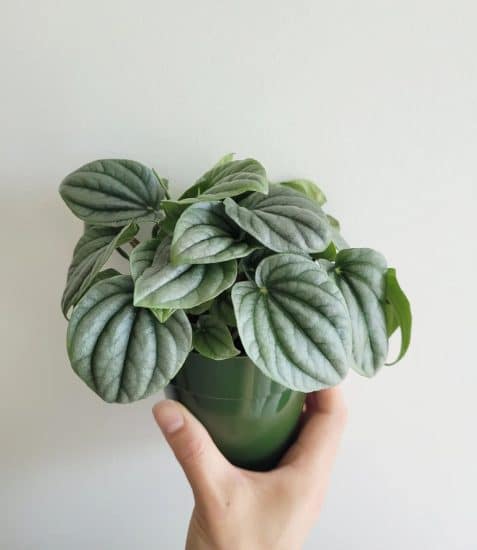
Peperomia Frost (Peperomia caperata ‘Frost’) hails from the tropical rain forests of Brazil, where it thrives in the warm, humid environment. It’s known for its deeply undulating dark-green veins and obovate leaves with a distinctive silvery cast, as well as inconspicuous blooms that resemble delicate, curious tendrils.
Never growing larger than a foot tall, the petite but mighty Peperomia Frost has an ace up its leaf — its water-storing prowess allows it to withstand longer dry periods between waterings. This makes it an ideal companion for those who forget to water or love to travel.
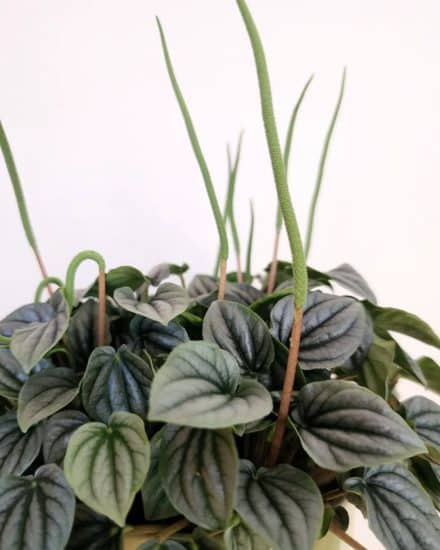
In the wild, this cultivar of the rippled peperomia can be found nestled on the rainforest floor, soaking in the dappled light, like its cousin the watermelon peperomia. And at a compact size of just 12 inches tall and wide, it’s happy to cozy up on a windowsill or mingle with other indoor plants in your urban jungle.
A curious texture and enchanting coloration make the Peperomia Frost a visual delight. With hints of purple nestled in the deeply valleyed veins and a frost-like coating, it’ll definitely catch the eye of any visiting friends or family.
Light

Peperomia Frost plants, originating from Central and South America, flourish when provided with bright, indirect light, similar to their natural habitat in tropical regions.
Be mindful of excessive sunlight, which can damage your Peperomia Frost. If you notice signs of leaf burn or leaf drop, your plant may be receiving too much direct sun. Faded, discolored leaves or small holes are other indicators of excessive sun exposure.
To prevent these issues, try placing your peperomia plant near a window with a sheer curtain, or move it to an area with bright, indirect light.
On the flip side, if your Peperomia Frost isn’t getting enough light, it may display leggy growth and reach toward the nearest light source. You might also observe a loss of vibrant color or variegation in the leaves. To correct this, relocate your plant to a brighter area or supplement with artificial lighting (LED grow lights are a great option).
Water
When it comes to Peperomia Frost planted in a soil mix, aim to water when the soil is half dry, making sure the pot drains completely and the topsoil dries before the next deep watering. Make sure not to leave your Peperomia Frost sitting in water, which could lead to issues with the root system.
For plants in LECA, which peperomias do quite well in, refresh the water once a month or when you see that salt has accumulated on the LECA balls. This is a sign that the water has evaporated and the plant is ready for more water.
Underwatering: Thirsty Peperomia Frost plants might display droopy leaves and a generally wilted appearance. It’s crucial to observe your plant closely and adjust your watering schedule accordingly, especially during the winter months when underwatering is more likely to occur.
Overwatering: Overwatering your Peperomia Frost can cause yellowing leaves and mushy stems, accompanied by consistently moist soil. Don’t let excess water sabotage your plant’s health — vigilance is key, and the right watering schedule can make all the difference.
Temperature and Humidity
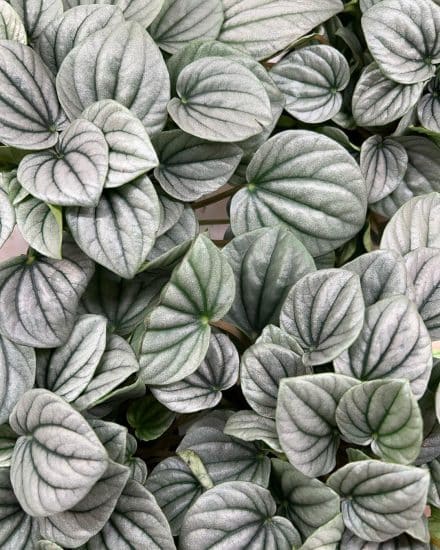
Peperomia Frost, also known as silver peperomia, thrives in the right balance of temperature and humidity. Let’s explore the ideal conditions for this houseplant’s health and happiness.
The ideal temperature for Peperomia Frost is between 65 and 75°F, but it can tolerate a range of 68 to 80°F. It’s crucial not to let the temperature drop below 50°F, because this tropical plant is sensitive to cold and will succumb to even a hint of frost (despite its name!).
Conversely, avoid high temperatures and too much hot sun, which can cause the heart-shaped leaves to dry out. Position your Silver Frost Peperomia away from heaters, air conditioners, and direct sun to prevent temperature fluctuations that can stress it.
For optimal air moisture, peperomia plants prefer humidity levels between 40% and 60%. However, they can adapt to typical home environments with 30%-40% humidity. Still, while Peperomia Silver Frost tolerates average household humidity, it does appreciate higher levels.
Monitor your Peperomia caperata for signs of temperature or humidity stress. Dry or wilting leaves may indicate too high or too low a temperature, respectively. If the plant isn’t growing well or seems lackluster, consider adjusting the humidity, especially if the leaf tips appear brown or crispy.
To raise humidity:
- Use a tray filled with water and pebbles under the plant, which releases moisture through evaporation.
- Group your Peperomia Frost with other humidity-loving tropical plants to share humidity through transpiration.
- Invest in a humidifier to maintain optimal humidity levels, especially during drier months.
Soil and Planting
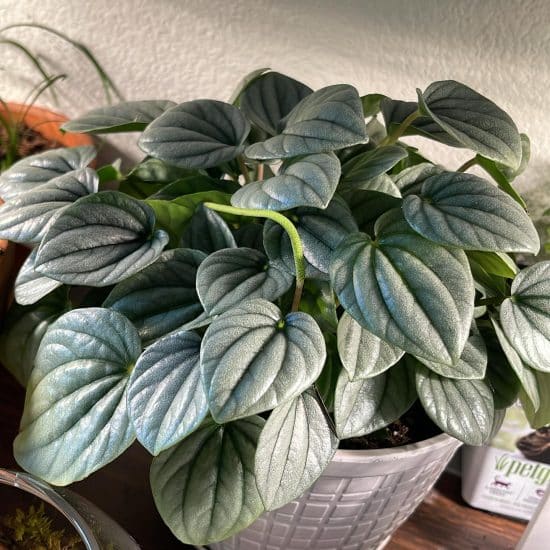
Caring for a Peperomia Frost requires the right soil and planting techniques. Let’s delve into the soil composition and planting methods that work best for this plant.
Moist potting mix: An 80/20 ratio of Miracle-Gro indoor potting mix and perlite ensures excellent drainage while supplying the necessary nutrients for your Peperomia Frost.
Including coconut coir, which is an eco-friendly alternative to sphagnum moss and peat moss, in the soil mixture will help your plant retain water effectively, ensuring your Peperomia Frost remains hydrated.
Alternatively, you can mix a ready-made, high-quality succulent soil with potting soil at a 50/50 ratio. Of course, LECA, lightweight expanded clay aggregate, is all the rage these days, and makes for an ideal potting medium for peperomia plants.
Fertilizer
While fertilizing isn’t necessary, if you choose to do so, go for a straightforward 20-20-20 fertilizer during spring and summer. Be aware of signs indicating excessive fertilizer use, such as yellow Peperomia Frost leaves, wilting, or stunted growth. If these occur, halt fertilizing and flush the soil with water to eliminate the excess.
Propagation
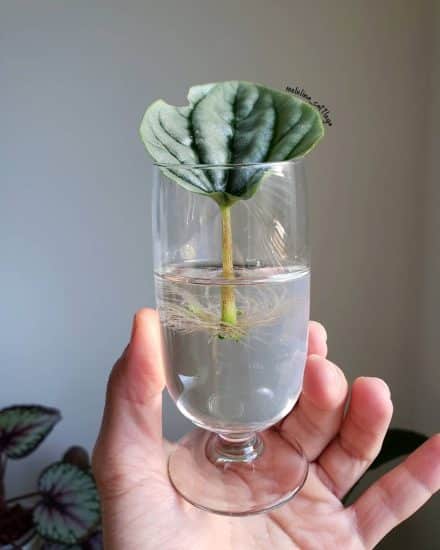
You can propagate Peperomia Frost using a leaf or stem cutting in LECA or water. In this guide, we’ll cover both techniques.
Propagating Peperomia Frost via stem cuttings:
- Take a good look at your Peperomia Frost and choose a healthy stem for propagation. Make sure the stem has a few healthy leaves. Use sterilized gardening shears to cut the stem cleanly, being careful not to damage the mother plant.
- To propagate using LECA, insert the stem cutting into moistened LECA, small clay balls that provide excellent drainage and aeration for plant roots. Use a container with a layer of moist LECA at the bottom and place the cutting in it. Keep the LECA moist and situate the container in an area with low light. Over the next few weeks, keep an eye out for the development of roots.
- For water propagation, fill a small container with filtered or bottled water and put the cutting in it. Be mindful not to submerge any leaves in the water to prevent rot. Position the container in a spot without direct sun. Refresh the water every few days, and within a couple of weeks, you should notice roots beginning to grow.
- When roots have grown to at least an inch long, carefully transplant your Peperomia Frost cutting into soil. Use a potting mix and bury the rooted cutting, ensuring the roots are fully covered. Keep the soil consistently moist but not waterlogged during the first weeks to allow the new plant to establish itself.
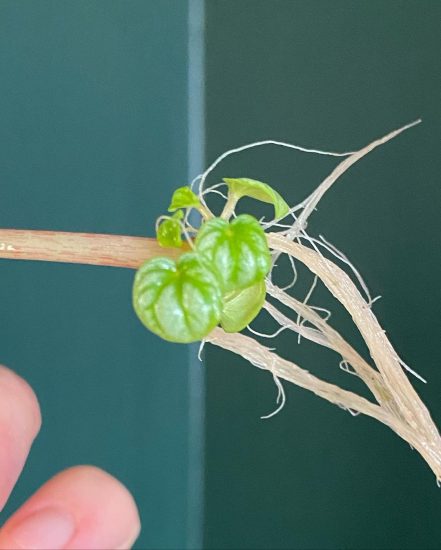
Propagating Peperomia Frost via leaf cuttings:
- Select a healthy, mature leaf from your Peperomia Frost. Use a clean, sharp pair of scissors or pruning shears to make a cut at the petiole (the stem connecting the leaf to the main plant).
- Allow leaf cuttings to air dry for a few hours, which helps the cut end heal and prevents rotting.
- Prepare a small planting container with well-draining soil, preferably a mix of perlite and potting soil.
- Insert the cut end of the petiole into the soil, making sure that the leaf is in contact with the soil surface.
- Place the container in a warm, bright spot with indirect sunlight, and maintain a temperature of 65-75°F for optimal growth.
- Keep the soil slightly moist until you see new growth, which typically takes a few weeks to a month.
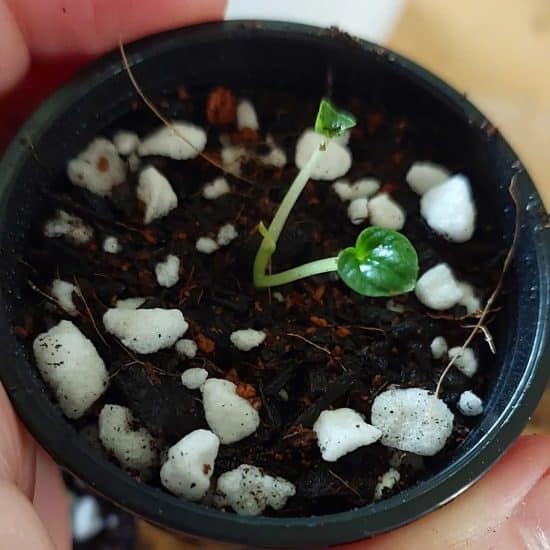
Common Issues
Peperomia Frost is generally a low-maintenance houseplant, but like any other peperomia plants, it can still run into some issues. Keep an eye out for these common problems, and follow our helpful tips to ensure your Peperomia Frost plant stays happy and healthy.
Yellow Leaves
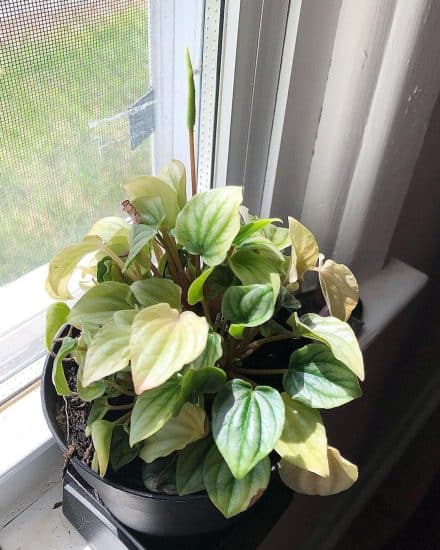
If your Peperomia Frost starts displaying yellow leaves, it’s often a sign of nutrient deficiency. Don’t fret — this is easily resolved with a diluted balanced fertilizer. Just remember not to overdo it, because excessively feeding your plant can lead to new issues.
Simply follow the label instructions to water your Peperomia Frost with the fertilizer solution, and watch as those yellow leaves regain their lush, green hue. Be sure to forgo fertilizer during the winter months, when plants are less active and need less feeding, as well as less water.
Fading Dull Leaves or Leaves Falling Off
Is your Peperomia Frost experiencing droopy and dull leaves? It might be due to insufficient lighting or inadequate temperature and humidity levels. To help your plant bounce back, move it to a brighter spot, but avoid direct sunlight, which can lead to leaf burn. In addition, make sure the temperature and humidity in your home are suitable.
Leaf drop can be concerning, but it’s typically caused by exposure to cold drafts or root rot. If your Peperomia Frost is near a window or door with chilly drafts, relocate it to a warmer area.
Pests and Diseases
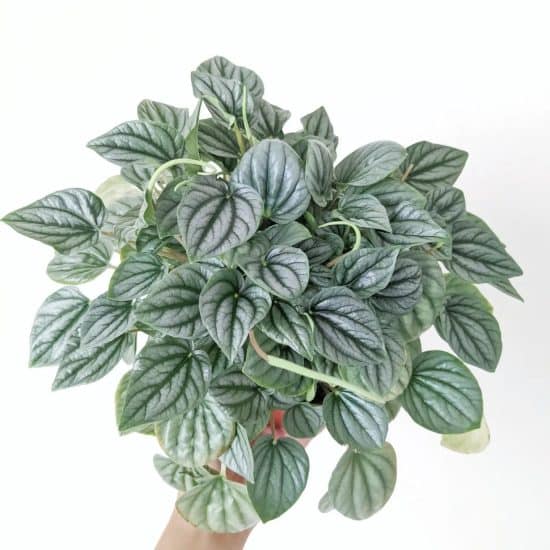
Pests
Luckily, Peperomia Frost is known for its natural pest resistance. But occasionally, it can still fall victim to spider mites, mealybugs, aphids, whiteflies, and more. If you notice small bugs, strange webbing, or damage on the leaves and stems, it’s time to take action.
First, isolate the peperomia plant to prevent the spread of pests to other plants. Then, use a natural insecticide like neem oil to control the invaders (always following the label instructions). Keep a close eye on your plant to make sure the problem is truly resolved.
Root Rot or Leaf Spot
Sometimes, Peperomia Frost can experience root rot or leaf spot caused by overwatering. To identify these issues, look for black or brown, slimy roots (indicative of root rot) and discolored spots on the leaves (a sign of leaf spot).
To tackle these problems, here’s what to do:
- Remove any affected roots or a few leaves using sanitized scissors.
- Repot your plant in fresh, well-draining soil, with added perlite, pumice, or LECA for better aeration.
- Make sure your pot has drainage holes, and choose a terracotta pot to avoid water buildup in the soil.
- Be mindful of your watering habits to prevent these issues from coming back. Let the top layer of moist soil dry out before watering again.
Conclusion
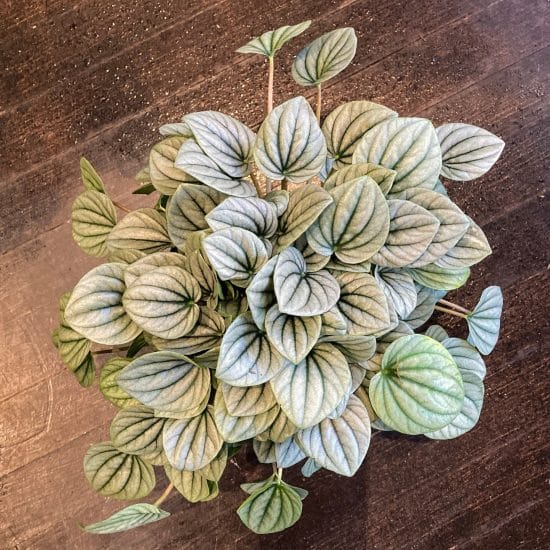
That concludes our Peperomia Frost care guide!
This delightful little houseplant is not only a looker but also low-maintenance and adaptable, making it an excellent choice for plant lovers of all levels.
Peperomia Frost care summary:
- Ensure your plant receives bright, filtered sunlight to prevent leaf burn or leggy growth.
- Water when the top half of the soil has gone dry or the LECA shows signs of salt deposits.
- Water less in winter and more in summer.
- Provide well-draining soil with a combination of potting soil, perlite, and coco coir to promote healthy root development. Drainage holes are essential.
- Maintain optimal temperature and humidity levels for your plant’s well-being, avoiding temperature fluctuations and drafts.
We hope this guide helps you care for your Peperomia Frost. If you have any questions or need further assistance, don’t hesitate to reach out. Feel free to share this guide with fellow plant lovers, and enjoy the beauty and charm of your Peperomia Frost!
Take care!
FAQ
Is Peperomia Frost easy to care for?
Yes! Peperomia Frost is actually a pretty easy-to-care-for houseplant, suitable for both seasoned plant enthusiasts and beginners alike.
To keep your Peperomia Frost happy and thriving, ensure that the plant has consistent 65-75°F temperatures and 40%-60% humidity, and is protected from drafts and drastic temperature fluctuations. Remember to provide bright, indirect sunlight and water it moderately, allowing the soil to dry out between waterings.
Is Peperomia Frost a succulent?
Not completely. While Peperomia Frost may look like a succulent due to its fleshy, rounded leaves, it is not a true succulent. Peperomias belong to the Piperaceae family, which is not related to the family of true succulents, Crassulaceae.
However, Peperomia Frost does share some characteristics with succulents, such as its preference for well-draining soil and ability to store water within its leaves. This makes it somewhat drought-tolerant, and forgiving if you occasionally forget to water it.
Is Peperomia Frost toxic?
No. Good news for pet owners and households with young children — according to the ASCPA, Peperomia Frost is considered nontoxic. However, it’s always best to keep plants out of reach of curious pets and children to prevent accidental ingestion and damage to the plant. Plus, while it may not be toxic, chewing on the leaves could still cause mild irritation, so it’s better to be safe than sorry.

